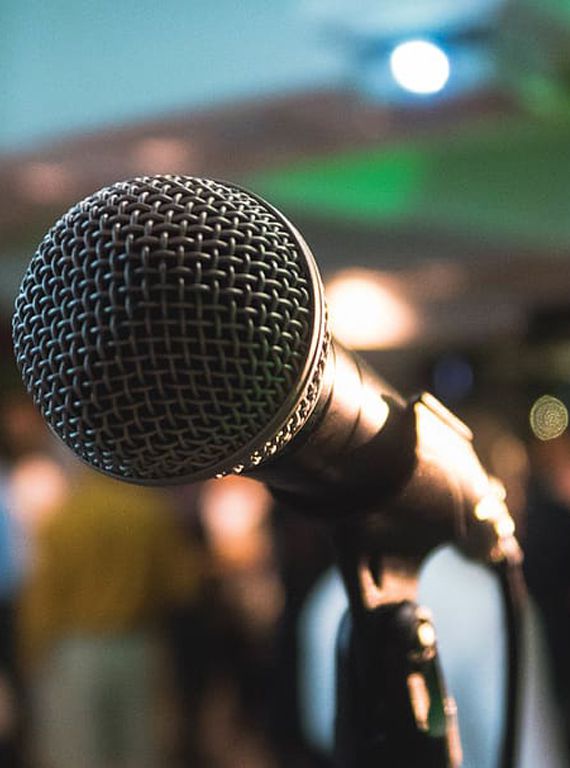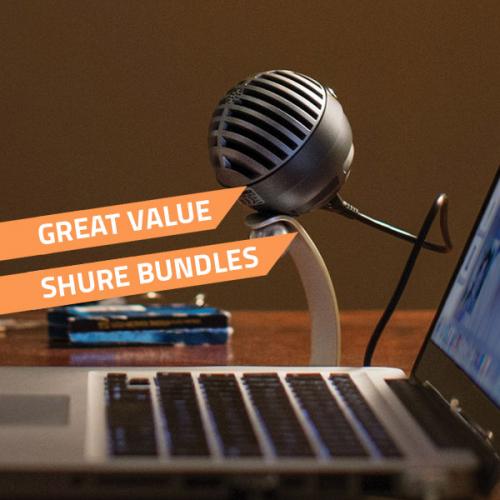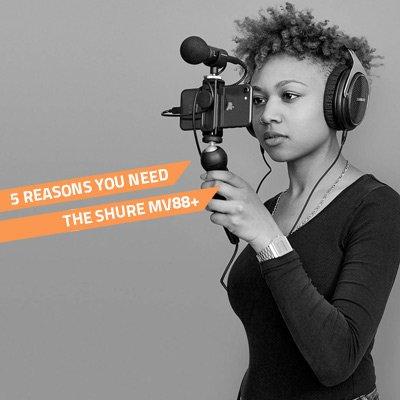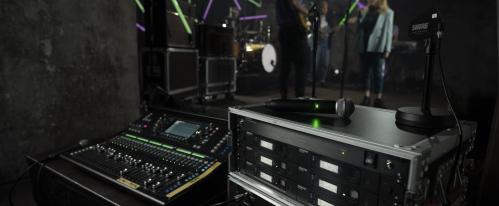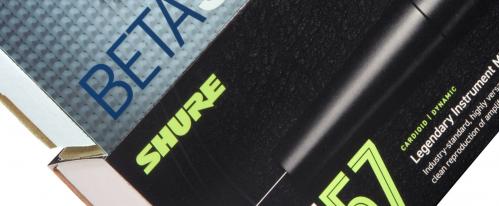SHURE SM86 AND SHURE SM58 TO HELP YOU DECIDE WHICH MICROPHONE MIGHT BE BEST FOR YOU. IT’S THE ULTIMATE SHOWDOWN AS WE PIT SHURE SM86 VS SHURE SM58!
If you’re looking for the best vocal microphone for the stage and studio, there is a huge amount of choice out there, but there are two specific microphones consistently relied upon by stage and studio musicians to get the best vocal sounds, and it almost always comes down to the Shure SM86 vs Shure SM58. But which one would you choose?
Struggling to figure out the differences between the Shure SM86 and Shure SM58? Look no further, as today we’re going to take a look at the similarities between these two high-quality microphones, what sets them apart and what the right option for you might be when it comes to the Shure SM86 Vs Shure SM58 battle.
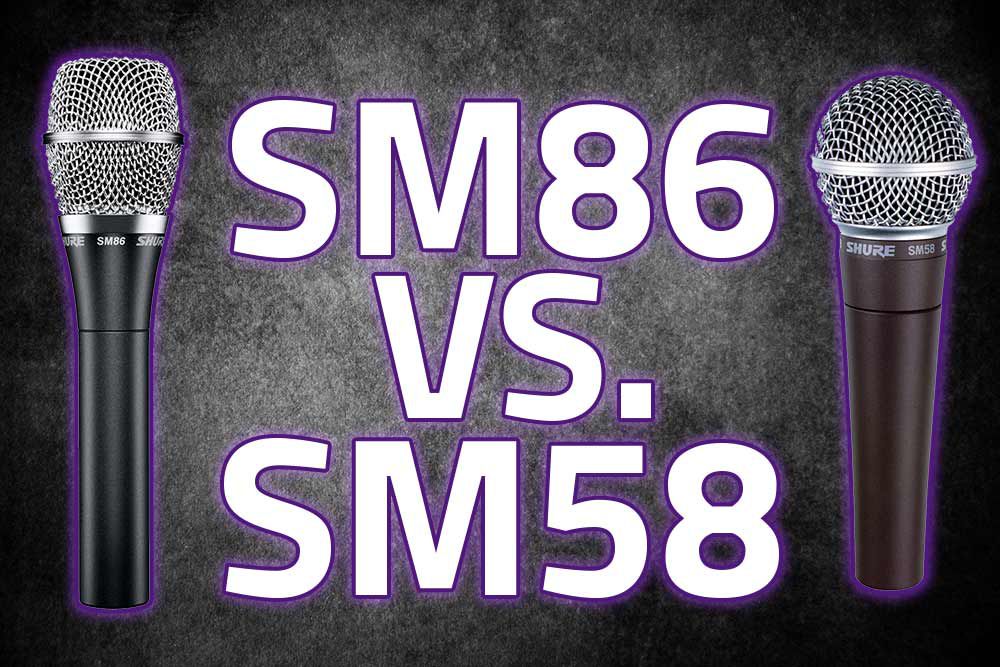
HOW ARE THE SHURE SM86 AND THE SHURE SM58 SIMILAR?
The major similarities between the Shure SM86 and Shure SM58 are:
- Both microphones feature a Cardioid polar pattern
- Both mics have an XLR connection
- Each are perfect for live and studio use
- Both mics are made by Shure in Mexico
- Both come with the Shure branded zipper bag and a mic clip
WHAT ARE THE DIFFERENCES BETWEEN THE SHURE SM86 AND THE SHURE SM58?
There are some key differences between the Shure SM86 and the Shure SM58 which you need to consider before you take the plunge and take either of these into the studio – without knowing the differences, you might not get the result you want!
DIFFERENT TYPES OF MICROPHONE
The major difference between each of these microphones is that they are two different types of mic entirely.
The Shure SM58 is a dynamic microphone whereas the Shure SM86 is a condenser microphone.
Shure SM86
It’s important to remember that Condenser microphones (Shure SM86) are best for capturing higher frequencies, delicate vocals, and ideal for studio use thanks to the fact that they can pick up a higher amount of detailed sounds.
With some condenser microphones, you might need a pop shield too, especially if you want to reduce the plosive sounds. Fortunately, the SM86 comes fitted with a pop shield grill which has been designed to reduce those annoying pops and plosive sounds making them ideal for live use.
Bear in mind as well, that condensers also need phantom power to create their high output.
Shure SM58
Dynamic microphones (Shure SM58) work best with those who have a louder voice as they are designed to record stronger signals (loud voices, screaming vocals, etc) and have a lower output thus reducing the amount of detail slightly, which is perfect if you’re capturing a strong signal such as a live singer who can really belt it out or a loud acoustic guitar, for example.
The Shure SM58 in particular is not as delicate as some other microphones as the wire coil within the microphone is protected by a pop shield installed within the mic and they don’t need a power source.
They also need little, to no maintenance thanks to high build quality and hard-wearing design. Speaking of build quality…
FREQUENCY RESPONSE AND SENSITIVITY
The Shure SM86 features a 50Hz – 18kHz frequency response, whereas the SM58 has a 50Hz – 15kHz frequency response.
This makes the SM58 better for louder, stronger signals and the SM86 a better choice for softer vocals, acoustic instruments and applications where you need more detail in your recording.
The Shure SM58 features a sensitivity of -54.5dBV/P whereas the Sm86 has a -50dBV/PA.
XLR CONNECTIONS
The SM86 features gold plated XLR pins for a slightly better (but noticeable) connection and more transparent sound transfer, whereas the SM58 features silver plated pins, which still provide a great connection, however purists may prefer the quality that gold-plated pins provide.
SHAPE, SIZE AND WEIGHT DIFFERENCES
There are some slight differences in the weight, shape and size of each mic. The SM86 weighs in at 278g and the SM58 weighs 298g – something to think about if you’re holding them for extended periods of time or swinging them around!
The shape of these microphones is slightly different as the SM86 has a square shaped grille and is longer than the Shure SM58. The SM58 features a rounded grille.
SOUND DIFFERENCES BETWEEN THE SHURE SM86 AND SHURE SM58
There are a few major sound differences to consider when comparing the Shure SM86 vs Shure SM58.
As the Shure SM58 is a dynamic microphone, it will reject background and ambient noise better, making it ideal for live vocals, whereas the SM86 is a little more prone to background noise given the fact it is a condenser – this makes the SM86 a better mic for those who want the “feel” of the environment to come through in the mix, whether live or in the studio.
If you want a more detailed and breathier sound, the SM86 is a better option. The SM86 is not as “boomy” as the SM58 and is less punchy overall, so if you want to record loud, screaming vocals, it may not be the best option.
SO WHICH IS THE BEST MICROPHONE FOR ME?
Considering both microphones are designed for stage and studio, both will work beautifully in either setting.
However, when considering the Shure SM86 Vs Shure SM58, if you want to record loud vocals, feel safer with an almost indestructible mic in your hand and not have to worry about phantom power, we’d recommend the SM58.
If you use in ear monitors, need a wider frequency range and want to be able to record acoustic instruments the Shure SM86 is a better option.
It’s a little more fragile than the SM58 but the sound is slightly less muddy and far more detailed. You do have to have access to phantom power though – so something to bear in mind!
IN SUMMARY
The Shure SM58 is best for:
- Loud vocals (metal bands, alternative etc.)
- Those who may drop or swing their mics
- Those who need a reliable workhorse of a mic for stage and studio
- Less detail in vocals
The Shure SM86 is best for:
- Singer songwriters
- Church vocalists
- Those who use in ear monitors and need to hear every detail of their voice
- Recording acoustic instruments and vocals in the studio
WANT THE BEST OF BOTH WORLDS? CHECK OUT THE SHURE BETA 58A
The Shure SM58 has been updated and upgraded resulting in the now-iconic Shure Beta 58A.
This high output vocal microphone takes all the indestructible qualities of the SM58 including the circular grille design, size and weight and provides increased sensitivity, high-frequency response as well as a Supercardioid pickup pattern which allows for beautiful capture of live vocals whether you’re busting out Slayer style vocals or gently setting the mood with acoustic guitar and soft vocals – this thing can handle it all.
In addition, the Shure Beta 58A rejects feedback and heavily reduces off-axis sound, making it ideal for capturing vocals and acoustic instruments in the studio setting.
The inner workings of the microphone are heavily protected thanks to the almost indestructible grille and mic handle construction and the advanced pneumatic shock mount system within reduces the transmission of mechanical noise and vibration.
Although you may be thinking to yourself which option might be best when it comes to Shure SM86 Vs Shure SM58 - if you want a great all-rounder that can record high-quality vocals in the studio and transfer perfectly to the live arena, this is probably your best option overall.
We feel it is the best of both worlds and one of the best microphones for recording vocals.
Shop a full range of Shure microphones & Shure Wireless Microphones over at PMT Online today or call into your local PMT store to speak to one of our PA experts about your bespoke needs.
We have a dedicated team ready to help you find everything you need, whether it’s a single microphone for on-stage use, a full studio setup, or even a full PA system complete with wireless microphones. Speak to our experts today on 0151 448 2089 and let us help you.
Updated: 2020-06-04

